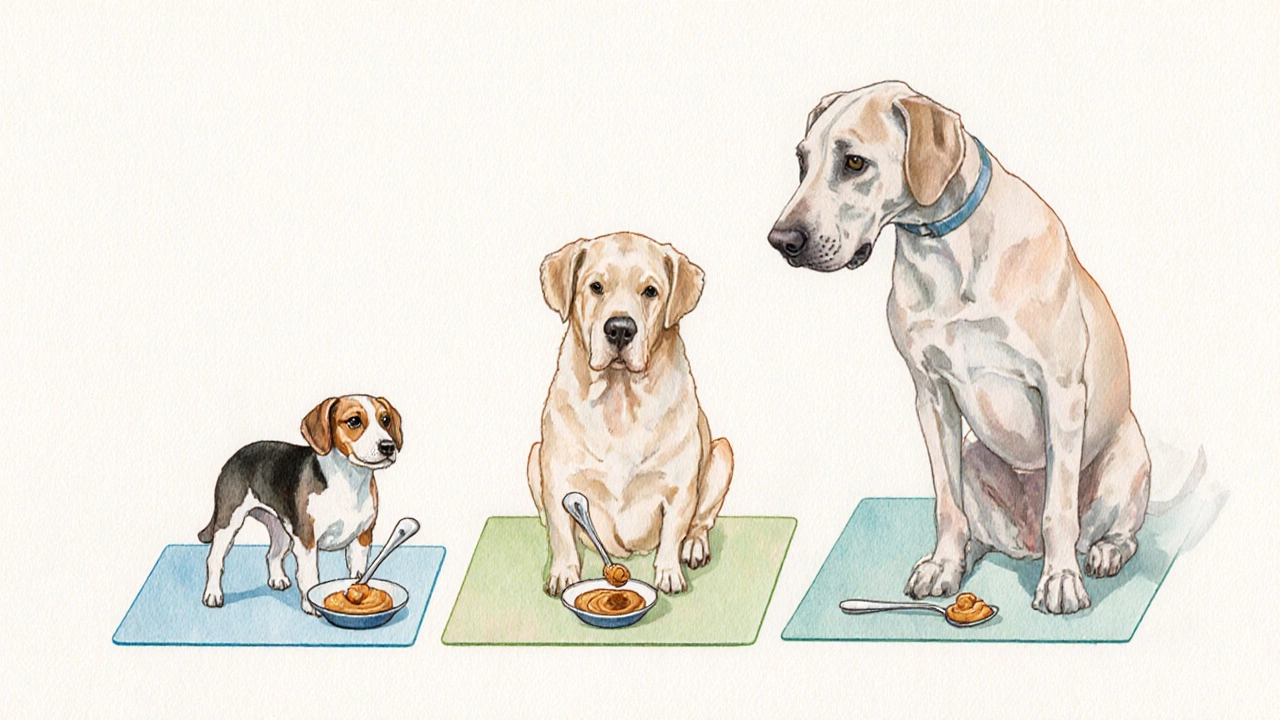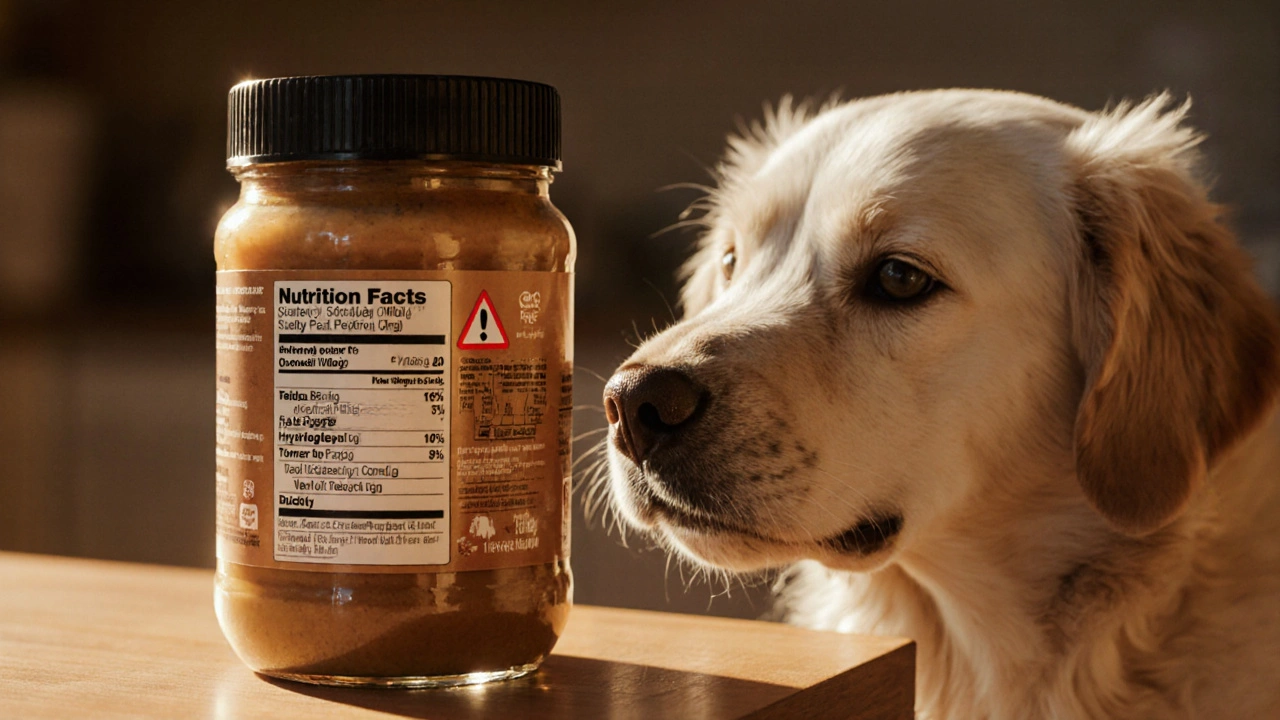Peanut Butter Safety Checker
Select the ingredients you see on your peanut butter label to determine its safety for dogs:
Select ingredients and enter your dog's weight to get safety recommendations.
Ever caught your pup sniffing around the kitchen and wondered if that sticky, nutty spread is a harmless treat or a hidden danger? dogs peanut butter is a question that pops up in almost every dog‑owner forum, and the answer isn’t as simple as a yes or no. In this guide we’ll uncover what peanut butter really is, which ingredients can hurt your canine, how to pick the safest option, and the best ways to serve it without risking health problems.
- Plain, unsalted, Xylitol‑free peanut butter is generally safe in moderation.
- Check labels for sweeteners, high salt, or added oils - those can cause trouble.
- One teaspoon per 20‑lb dog is a good rule of thumb for calories.
- Watch for signs of allergy or digestive upset.
- If in doubt, ask your veterinarian before making it a regular treat.
What is Peanut Butter?
Peanut butter is a paste made by grinding roasted peanuts into a smooth or crunchy spread. It typically contains three core components: peanuts, a small amount of oil (often added to improve texture), and salt. Commercial brands may also add sugar, hydrogenated oils, and artificial sweeteners to boost flavor and shelf life.
Peanut butter is a food paste primarily composed of ground peanuts, often enriched with salt, sugar, and stabilizing oils. In the United States, the FDA defines “peanut butter” as a product containing at least 90% peanuts, but the remaining 10% can vary widely between natural and highly processed versions.
How Dogs Digest Peanut Butter
Dogs have a shorter gastrointestinal tract than humans, which means food passes through more quickly. Their stomach acidity is higher, helping them break down protein, but they lack the enzyme amylase in saliva, so carbohydrate digestion starts only in the small intestine.
Dog a domesticated carnivore with a digestive system adapted for high‑protein, moderate‑fat diets. When a dog eats peanut butter, the high fat content is absorbed in the small intestine, providing a quick energy boost. However, excess fat can overwhelm the pancreas, especially in breeds prone to pancreatitis.
Ingredients That Can Turn Peanut Butter Into a Hazard
Not all peanut butter is created equal. Below are the common culprits you should scan for on the label:
- Xylitol is a sugar substitute highly toxic to dogs, causing rapid insulin release and potentially fatal hypoglycemia. Even a tiny amount can be lethal, so any product that lists “sugar‑free” or “low‑calorie” should be avoided.
- Salt is sodium chloride added for flavor, which in high amounts can lead to dehydration and electrolyte imbalance in dogs. Look for “unsalted” or “no added salt” versions.
- Sugar is a simple carbohydrate that contributes empty calories and can exacerbate weight gain or diabetes in dogs. Choose products with no added sugar.
- Hydrogenated oils - these trans fats can raise blood cholesterol and are unnecessary for a dog’s diet.
When in doubt, read the ingredient list from top to bottom; the first three items give you the best idea of the product’s composition.
Natural vs. Commercial Peanut Butter: Which Is Safer?
| Attribute | Natural Peanut Butter | Commercial Peanut Butter |
|---|---|---|
| Ingredients | 100% peanuts, optional salt | Peanuts + sugar + hydrogenated oils + salt |
| Calories (per tbsp) | 90 kcal | 100‑110 kcal |
| Added Sweeteners | None | Often contains sugar or artificial sweeteners (may include xylitol) |
| Recommended for Dogs? | Yes, if unsalted and no added sugars | Only if label confirms "no xylitol" and low salt |
Natural peanut butter generally has fewer additives and a cleaner ingredient list, making it the safer choice for a dog treat. If you opt for a commercial brand, double‑check that it’s labeled “xylitol‑free,” “unsalted,” and “no added sugar."

How Much Is Too Much? Serving Size Guidelines
The biggest risk of feeding peanut butter is the extra calories. A typical 20‑lb dog should get no more than one teaspoon (about 5g) per day. Larger dogs can handle up to one tablespoon, but always factor it into the total daily calorie budget.
For reference, a medium‑size Labrador (70lb) needs roughly 1,400kcal per day. One tablespoon of natural peanut butter adds about 90kcal, which is roughly 6% of the daily allowance - acceptable if balanced with reduced portions elsewhere.
Weight‑watching dogs, senior dogs, or those with joint issues should treat peanut butter as an occasional indulgence.
Best Ways to Serve Peanut Butter to Dogs
- Use it as a high‑value training treat: Spoon a dab onto a lick mat or flatten it on a small cookie cutter for bite‑size pieces.
- Hide medication: Fill a hollow chew toy with a thin layer of peanut butter, then give it to your dog to lick clean.
- Freeze it: Mix one part peanut butter with two parts plain yogurt, spoon into ice cube trays, and freeze for a cool summer snack.
- Combine with fruit: A thin smear on banana slices or apple wedges adds variety and extra fiber.
Always supervise the first few servings to see how your dog reacts. If you notice vomiting, diarrhea, or excessive gas, stop immediately and consult a vet.
When to Skip Peanut Butter Entirely
Some dogs are allergic to peanuts, and a reaction can look like itching, ear infections, or even gastrointestinal upset. If your dog shows any of these signs after a first taste, discontinue use and see a veterinarian a medical professional specializing in animal health.
Dogs with pancreatitis, diabetes, or obesity should avoid high‑fat treats like peanut butter unless specifically approved by a vet. The extra fat can trigger a flare‑up of pancreatitis, while the sugar can destabilize blood glucose in diabetic dogs.
In short, avoid peanut butter if your dog has any of the following conditions:
- Known peanut allergy
- Pancreatitis (inflammation of the pancreas)
- Diabetes mellitus
- Obesity or a history of rapid weight gain
Quick Safety Checklist
- Choose plain, unsalted, Xylitol‑free peanut butter.
- Serve no more than 1tsp per 20lb of body weight.
- Watch for allergic reactions or digestive upset.
- Consult your veterinarian if your dog has existing health issues.
Frequently Asked Questions
Can I give my dog any brand of peanut butter?
No. Only choose a brand that lists 100% peanuts, no added sugar, and absolutely no Xylitol. Natural, unsalted varieties are the safest.
How do I know if my dog is allergic to peanuts?
Allergic signs include itching, red skin, ear infections, vomiting, or diarrhea after the first exposure. Stop feeding peanut butter immediately and schedule a vet check.
Is peanut butter good for a dog’s coat?
In moderation, the healthy fats can give the coat a nice shine, but the benefits are outweighed by the calorie load if you overfeed.
Can I mix peanut butter with other dog foods?
Yes, a thin layer on top of kibble or mixed into canned food can make a bland diet more appealing, but keep the total portion small.
What should I do if my dog eats peanut butter with Xylitol?
Contact an emergency veterinary clinic right away. Xylitol can cause life‑threatening hypoglycemia within 30minutes.

